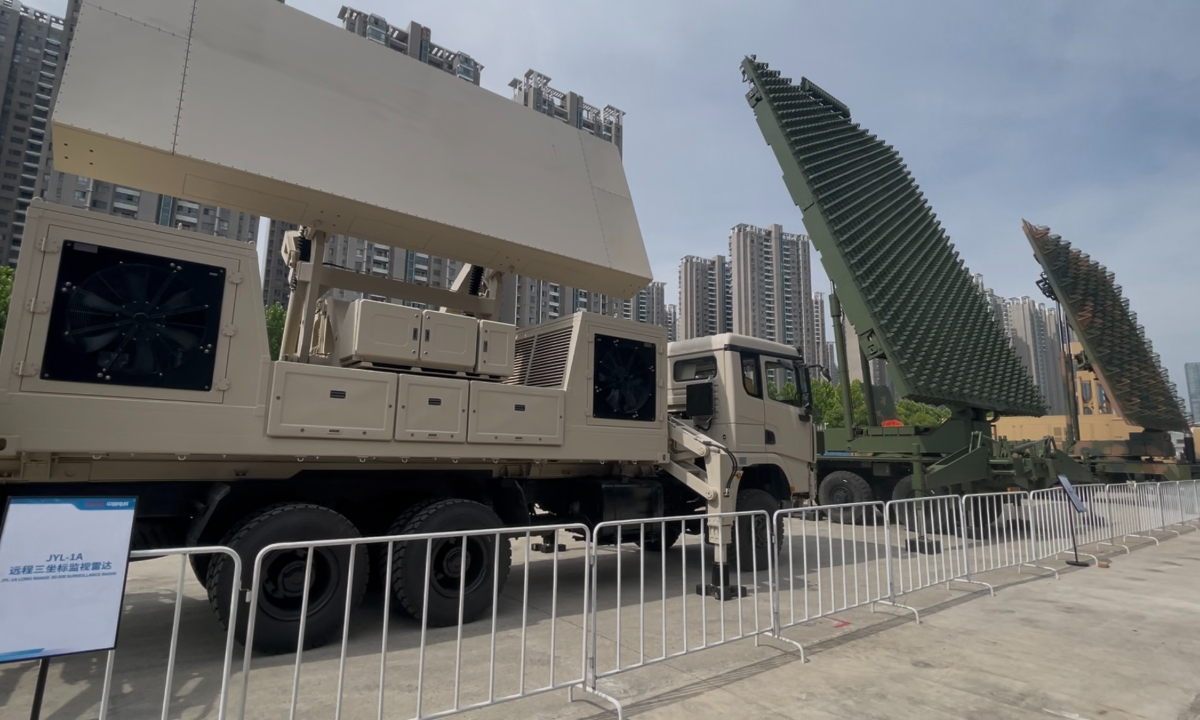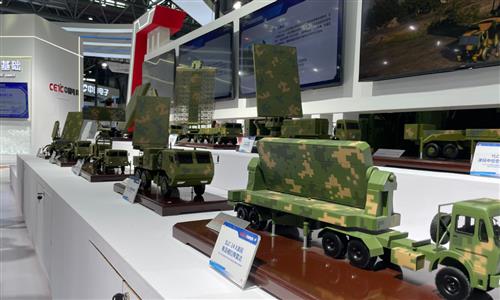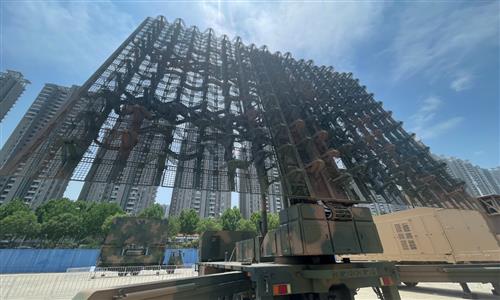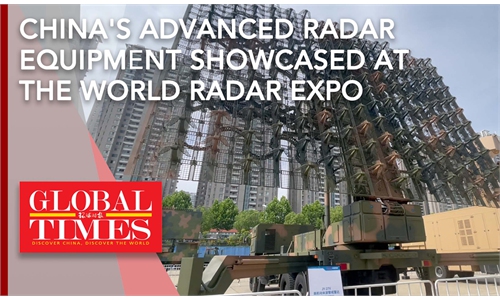China puts advanced detection, command and control systems on display at radar expo

Radar systems developed by the state-owned China Electronics Technology Group Corporation (CETC) on display at the 11th World Radio Detection and Ranging Expo (World Radar Expo) on May 17, 2025, in Hefei, East China's Anhui Province. Photo: Liu Xuanzun/GT
In recent regional conflicts, the battle for dominance in the electromagnetic domain, represented by radar technology, has become a decisive factor in determining the outcome on the battlefield. Against this backdrop, the Global Times visited the 11th World Radio Detection and Ranging Expo (World Radar Expo), which is being held from Saturday to Monday in Hefei, East China's Anhui Province, to learn about China’s world-leading radar technologies.
At the outdoor exhibition area of the expo, several towering radar equipment installations were the most eye-catching. The state-owned China Electronics Technology Group Corporation (CETC) has unveiled multiple types of anti-stealth radars as star products of China's radar equipment this year. Among them is the brand-new JY-27V high-mobility meter-wave air surveillance radar, a next-generation meter-wave anti-stealth radar.
Current stealth fighter jets or stealth missiles are not truly all-band stealth. They are typically only effective against higher-frequency C-band or X-band waves used by threat-heavy fire-control radars or guidance radars, making them more susceptible to detection by lower-frequency meter-wave radars. This is the so-called band-based anti-stealth systems.
Xu Haizhou, an expert at CETC’s 38th Research Institute, told the Global Times that the institute has solved challenging questions such as relatively big multipath effect, less optimal terrain adaptability, inconsistent air coverage and poor accuracy.
Through extensive improvements in meter-wave radar technology, including microwave active array and software algorithms, the institute has successfully developed the “Sky Watcher” series of early warning radars, Xu said, noting that the JY-27V radar that is on display at the expo is a latest product in the series, which is characterized by its long detection range, high detection accuracy, high intelligent level and high mobility. It has a unique, large array design and significant spread-retract ratio, which allows for rapid deployment and retraction within a few minutes, realizing detection accuracy comparable to microwave radars.
Whether it is modern battlefields, counter-terrorism operations, or urban security, the threat posed by low, slow, and small targets such as small or mini drones is growing. Effectively countering these drones makes timely detection a primary challenge. At 2025’s radar exhibition, CETC presented solutions tailored to different scenarios.
One of them is the YLC-12 C-band medium- and low-altitude multirole radar, a star system in low-altitude airspace surveillance. It effectively addresses the challenges of detecting medium- to low-altitude targets that are small, slow-moving, or highly maneuverable. Boasting superior low-altitude detection performance, high adaptability to deployment conditions, excellent mobility, strong resistance to complex electromagnetic environments, and accurate target radar identification capabilities, this radar stands out as a cutting-edge solution. To better adapt to complex electromagnetic environments, it incorporates an intelligent anti-jamming design philosophy, ensuring optimal countermeasure effectiveness by dynamically aligning radar anti-jamming techniques with prevailing interference conditions.
The experience of several regional conflicts in recent years has deepened the world's understanding of systematic warfare. However, achieving joint systematic operations involving multiple combat elements, units, and even services and branches across large areas places extremely high demands on informationized equipment. Currently, only a handful of countries worldwide possess such capabilities.
At this radar expo, CETC’s 28th Research Institute unveiled a type of mobile command vehicle that features capabilities such as all-domain situational awareness, multi-domain joint planning, and collaborative action control. An expert from the institute told the Global Times that the command vehicle can integrate and analyze information obtained from different platforms and units, such as intelligence from various battlefield radars, electronic reconnaissance, and drones, to form a clear and comprehensive battlefield picture for commanders to make decisions. Additionally, it assesses threats posed by enemy targets on the battlefield in real time, identifies threat levels, and rapidly generates corresponding interception and strike plans.
Due to the widespread use of modern battlefield sensors, an overwhelming amount of battlefield intelligence is generated, making it a global challenge how to effectively screen and integrate all the intelligence and quickly form combat plans. According to the expert, the mobile command vehicle not only employs traditional algorithms but also leverages cutting-edge big data and large models. From target detection to final decision-making, the entire process takes only a few seconds, significantly enhancing combat efficiency compared to traditional command models.
The expert at the 28th Research Institute said that, to develop similar intelligent command and combat capabilities, it is not only necessary to integrate various combat elements into a network through reliable battlefield communication technology and universal data link technology, but also requires efficient intelligence processing technology, decision-making assistance technology, and comprehensive engineering expertise. Additionally, there is a high demand for the intelligent integration of intelligence information. This is why only a handful of countries worldwide possess such capabilities.




